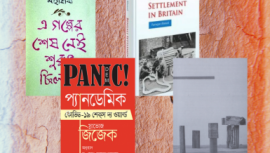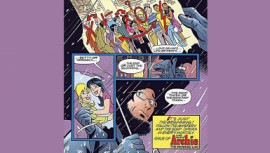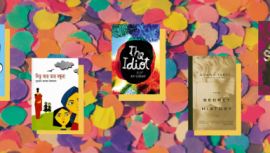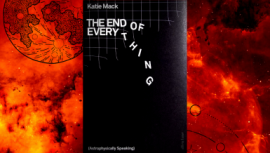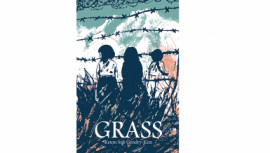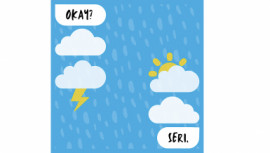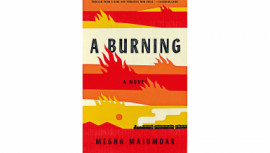-
![Revisiting forgotten babyhood days with ‘Babuibela’]()
Revisiting forgotten babyhood days with ‘Babuibela’
Every emotion associated with pregnancy and childbirth is amplified...
-
![New online journal ‘Kitchen Sink’ promises an accessible platform for poets]()
New online journal ‘Kitchen Sink’ promises an accessible platform for poets
About a month ago, a few friends sent me invites to follow the...
-
![The book that I would like to read]()
The book that I would like to read
Today I would like to talk about a book that I have been waiting to...
-
![Tahmima Anam’s ‘The Startup Wife’ arrives at Baatighar]()
Tahmima Anam’s ‘The Startup Wife’ arrives at Baatighar
Tahmima Anam’s fourth and latest novel, The Startup Wife (Penguin...
-
![Is Netflix’s ‘Ray’ worth the watch?]()
Is Netflix’s ‘Ray’ worth the watch?
Netflix’s latest anthology series, Ray, is based on four short...
-
![Who is Ayad Akhtar?]()
Who is Ayad Akhtar?
When I began reading Homeland Elegies (Little, Brown and Company,...
-
![Colm Tóibín takes Henry James for a ride]()
Colm Tóibín takes Henry James for a ride
In a detour from all the genres and topics that we review on this...
-
![Ann Patchett’s ‘The Dutch House’: On branches of memories and pain]()
Ann Patchett’s ‘The Dutch House’: On branches of memories and pain
Even though we moved out of our grandmother’s house in Dhaka more...
-
![A tribute to my father and his bookshelf]()
A tribute to my father and his bookshelf
Last week, we marked the 10th year of my father’s death, on June...
-
![Unpacking Bangladesh’s obsession with Bollywood]()
Unpacking Bangladesh’s obsession with Bollywood
Mrittika Anan Rahman (MAR): What does it say about Bollywood that...
-
![Feminism, activism, and literature: The legacy of Sufia Kamal]()
Feminism, activism, and literature: The legacy of Sufia Kamal
Sufia Kamal’s is a name revered in nearly every household in the...
-
![Sensing Bangladesh through art and poetry]()
Sensing Bangladesh through art and poetry
In their latest offering, Sensing Bangladesh – A Children’s...
-
![‘The Moment of Lift’: Melinda Gates and the developing world’s untapped female-fuel]()
‘The Moment of Lift’: Melinda Gates and the developing world’s untapped female-fuel
Female empowerment is often seen as a luxury reserved for...
-
![Books to read if you miss travelling this summer]()
Books to read if you miss travelling this summer
I know it’s hard when you want to travel, but life, owing in no...
-
![Of the peasants’ quest for a state and Bangabandhu Sheikh Mujibur Rahman]()
Of the peasants’ quest for a state and Bangabandhu Sheikh Mujibur Rahman
Afsan Chowdhury’s Sheikh Mujibur Rahman and Bangladesh: The Quest...
-
![For lovers of traveling and history]()
For lovers of traveling and history
Shamsul Alam’s From Love Lane to the World: Tales of Travel &...
-
![IFIC Kali O Kolom Young Writers Award 2020 winners announced]()
IFIC Kali O Kolom Young Writers Award 2020 winners announced
Sponsored by IFIC Bank, this year’s Kali O Kolom Torun Kabi O...
-
![Soumitra Chatterjee: The one man behind the many]()
Soumitra Chatterjee: The one man behind the many
It is impossible to ascribe any one particular character to...
-
![Forgiveness, growth, and second chances in Sarah Hogle’s ‘Twice Shy’]()
Forgiveness, growth, and second chances in Sarah Hogle’s ‘Twice Shy’
Reading Sarah Hogle’s Twice Shy (GP Putnam’s Sons, 2021) is like...
-
![My learning from Anne Frank as she turns 92]()
My learning from Anne Frank as she turns 92
Not all books fulfil the purpose of exploring metaphors or offering...
-
![Tahmima Anam launches and discusses ‘The Startup Wife’ at Hay Festival]()
Tahmima Anam launches and discusses ‘The Startup Wife’ at Hay Festival
On June 3, 2021, Bangladeshi-born British writer Tahmima Anam...
-
![A truly ‘Invincible’ comic book series]()
A truly ‘Invincible’ comic book series
While DC and Marvel, the two big dogs of the comic book industry,...
-
![Relationships lost and found in debut novel ‘Punyaha’.]()
Relationships lost and found in debut novel ‘Punyaha’.
In the middle of nowhere, among the wide expanse of paddy fields...
-
![A handbook for navigating the social media age in your profession]()
A handbook for navigating the social media age in your profession
While the world might seem like a place only made for extroverts,...
-
Must reads out from Bangladesh in 2020
The 40 poems and photographs of wooden sculptors in Water Bodies reflect poet-artist Nabil Rahman’s experiences with art, immigration, intergenerational trauma, artificial intelligence, spirituality, and more.
-
Growing up with ‘Archie’ comics
As a tiny five-year old in the ’80s, I first discovered and liberated an Archie comic from a teenage cousin the way oil rich countries are liberated: by force. I used superior tactics of crying, pleading, whining and bargaining.
-
BACK TO SCHOOL: Campus novels worth revisiting
Instead of the thrill of meeting friends and professors in a bustling, energised campus, going back to school only involves a computer this September.
-
There will be darkness again
As humans we teeter on the oddest of precipices. We are only animals: apes unusually adept at surviving Earth’s harsh playbook for life. Like the multitude of organisms we share it with, we live, multiply, and without exception, we die.
-
Crimes that history cannot absolve
Korean literature has been enjoying a literary renaissance for quite some time through translation, from the likes of Hang Kang’s beguiling yet gruesome novel, The Vegetarian (2007) to Yeonmi Park’s heart wrenching memoir, In Order to Live (2015).
-
Bollywood’s ‘The Fault in Our Stars’: Okay? Not Okay?
When The Fault in Our Stars (2012) first released, it brought on a powerful surge of change, not only in our reading lists, but in our perception of terminal and mental diseases and even to the genre itself.
-
The stillness of human wandering
When we think of migration, the images in our collective narratives are constructed primarily with masses of people on the move, leaving places they belong in for foreign lands. In her latest book, Sonia Shah, an American science journalist and author, critically takes apart the boundaries around human wandering both in our lands and our mind-sets.
-
New publication on UK Bengali settlement out on Kindle
Migration of Bengalis from South Asia to the outside world started with taking up jobs as lascars (sailors) in the British East India Company's ships which carried precious goods from the Indian subcontinent, such as spice, tea and cotton. In addition, from the second half of the nineteenth century, Bengali educated and wealthy gentlemen began travelling to England mainly to pursue higher education.
-
A Burning: Good Books Are Hard to Read
Good books – even as they are arresting – are often hard to read. This is not because they are difficult in themselves so much because oftheir content.
-
Has young adult fantasy become rote as a genre?
Everyone had them on their bookshelves. Everyone read them and fawned over them. Online stores were getting creative with the contents of these young-adult fantasy books, coming up with themed candles, beautifully designed bookmarks, and exclusive sticker packs. It was almost as though the genre had developed a cult following of its own.

























